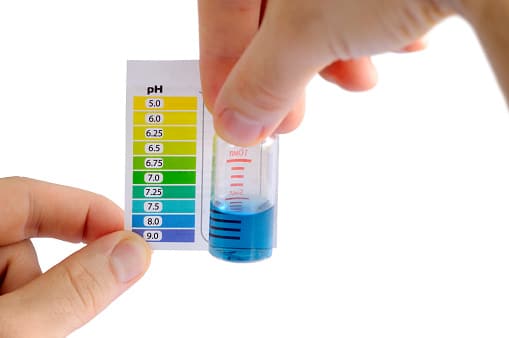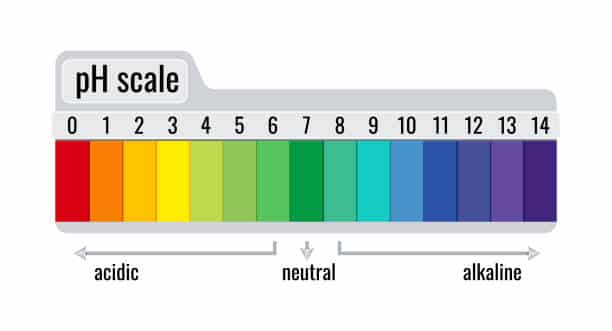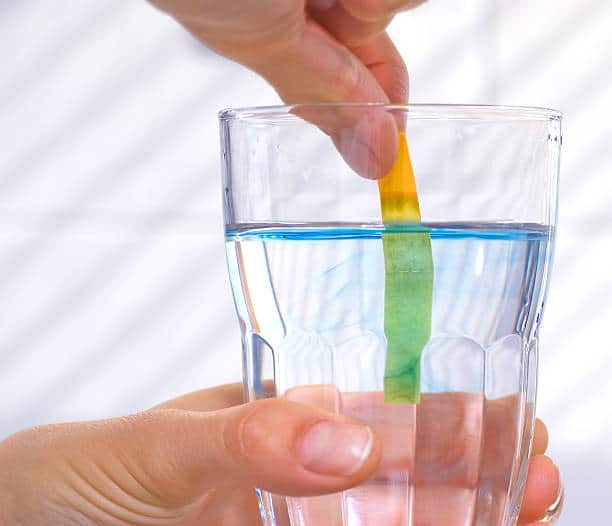According to the U.S. Environmental Protection Agency, the pH of water sources should be measured at a level between 6.5 and 8.5 on a scale from 0 to 14.
The ideal pH for drinking water is 7, which is just in the middle.

Due to a higher pH level, water that falls outside this threshold may indicate the presence of heavy, dangerous metals or compounds.
Typically, the health and safety of customers are not directly impacted by the pH of the water. However, because pH impacts how water interacts with its surroundings, it is one of the most crucial water quality characteristics that must be evaluated.
What is pH?
With 0 being the most acidic, 7 being neutral, and 14 being the most alkaline, pH is a gauge of acidity or alkalinity. Lehninger’s Principles of Biochemistry states that the technical definition of pH is the negative logarithm of the concentration of hydrogen ions in a solution.
The relative balance between positively and negatively charged ions in a solution is measured by pH in non-mathematical terms. These charged molecules in water are created during the dissolution of chemical substances.
The capital H in pH stands for either potential hydrogen or power of hydrogen since it reflects the element’s symbol.
Drinking water pH level chart
Here is a short and useful graph that shows the pH of drinking water:

How does pH affect drinking water?
Drinking water’s pH has an impact on it by modifying its appearance, taste (in a very subtle way), corrosiveness, and disinfection process effectiveness.
Humans can tolerate a wide variety of water pH values. Hence pH as a parameter has only modest effects on the safety or flavor of drinking water itself.
The following four aspects of drinking water are mainly impacted by pH:
- Aesthetic qualities: At high pH levels, water’s physical features, including color, odor, turbidity, and taste, are affected. This does happen, albeit it is uncommon and frequently includes interaction with other elements like corrosiveness.
- Effectiveness of disinfection: The most widely used water disinfectant in the world is chlorine, and pH affects how effective it is. According to the WHO’s Drinking Water Quality Guidelines, pH levels must be lower than 8 for chlorine to disinfect water sources effectively. 92% of the chlorine-based disinfectants are present at pH 6.5, but this decreases to 11% at pH 8.5.
- Corrosiveness: One aspect that affects how corrosive water is pH. Metal ions erode into the water when corrosivity increases. However, pH is only one aspect, and water at various pH levels has varied degrees of corrosivity. Minerals, temperature, oxygen content, electrical conductivity, and other elements all have an impact. Distilled water with a pH of 7 is corrosive because it lacks minerals and absorbs things more easily, especially metals.
- Taste: Water with a low pH has a sour or metallic flavor, whereas water with a high pH has a bitter or baking soda flavor. Tea or coffee also inherits the bitter flavor.
What are common drinking water pH levels?
These are typical pH values for drinking water for various types of water.
- Tap water. Highly variable, average pH of 7.5
- Distilled water. pH 5.8 – 7
- Bottled water. Highly variable based on source, pH 5 – 10
- Ocean water. pH 8 – 8.1
- Sparkling water. pH 4.5 – 6
- Iceberg water. pH 6 – 8
- Mineral water. pH 5.5 – 8.5
- Spring water. pH 6.5 – 8.5
- Artesian water. Highly variable based on ground geology, pH 6.5 – 8.5
- Alkaline water. pH 8-10
How much water should I be drinking?

Your body is continually losing water, even though you might not be aware of it. Your body is probably already utilizing and eliminating the gallon of water you just drank.
Your body exhales water through breathing, peeing, sweating, and other bodily processes. It’s crucial to refill your water supply as much as you can as a result. Your body will function better the more water you provide it with.
The recommended daily water intake for men is 3.7 liters, while the recommended daily water intake for women is 2.7 liters.
Once more, these are averages. Some people require more, while others require less.
Check out our best alkaline water pitchers if you’re looking to boost your pH.
Conclusion
The pH of water used for drinking or domestic purposes is crucial. Overly alkaline or too acidic water is generally unhealthy to consume and can harm appliances and pipelines.
Water pH often ranges between 6.5 and 8.5, which is normal. It might not be safe to drink water that is too far outside of this scale.

Jay
Jay is a health and wellness enthusiast with expertise in water quality and nutrition. As a knowledgeable advocate for holistic well-being, Jay successfully manages Type 2 Diabetes through informed lifestyle choices. Committed to sharing reliable and authoritative insights, Jay combines firsthand experience with a passion for enhancing health."


